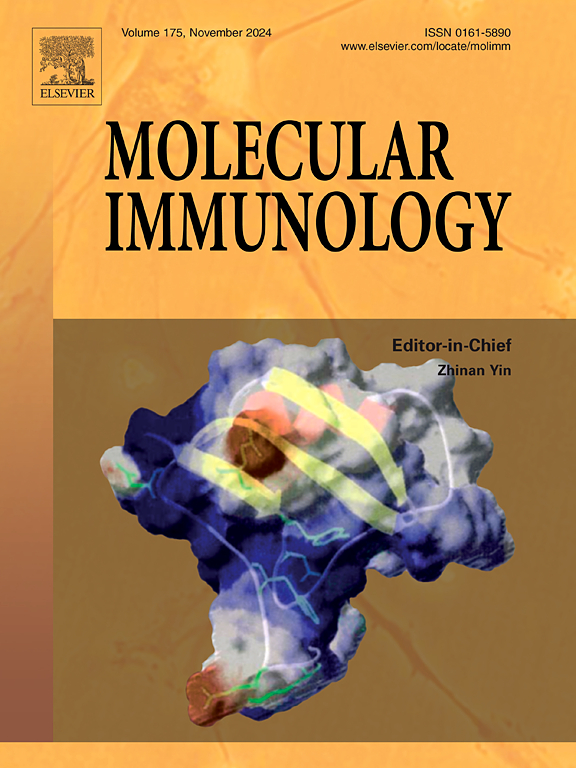Knockdown of FSTL1 attenuates sepsis-induced acute lung injury by inhibiting inflammation and ferroptosis
IF 3
3区 医学
Q2 BIOCHEMISTRY & MOLECULAR BIOLOGY
引用次数: 0
Abstract
Sepsis is a life-threatening condition characterized by high morbidity and mortality, with acute lung injury being the earliest and most severe complication. The damage to pulmonary microvascular endothelial cells (HPMECs) resulting from excessive inflammation plays a critical role in sepsis-induced acute lung injury (si-ALI). This study aimed to elucidate the role of Follistatin-like protein 1 (FSTL1) in si-ALI and its underlying pathophysiological mechanisms. We established an in vitro model of HPMECs stimulated by lipopolysaccharide (LPS), revealing a significant upregulation of FSTL1 at both mRNA and protein levels. Knockdown of FSTL1 mitigated inflammation by inhibiting the secretion of interleukin-1β (IL-1β) and interleukin-6 (IL-6), reducing reactive oxygen species (ROS) production, malondialdehyde (MDA) and ferrous ion (Fe2 +) levels, while simultaneously increasing glutathione (GSH) levels. Moreover, western blot showed that the knockdown of FSTL1 effectively suppresses cellular ferroptosis through the upregulation of SLC7A11, GPX4, and FTH. Conversely, FSTL1 overexpression exacerbated inflammation and ferroptosis, an effect reversible partly by the ferroptosis inhibitor Ferrostatin-1 (Fer-1). Furthermore, utilizing cecal ligation and puncture (CLP) method to establish sepsis mice model demonstrated that silencing of FSTL1 alleviated lung tissue damage associated with sepsis-induced pulmonary injury while inhibiting IL-1β and IL-6, ROS production, and ferroptosis. In conclusion, our findings indicated that knockdown of FSTL1 significantly improved si-ALI both in vitro and in vivo, suggesting it as a potential therapeutic target for managing sepsis-induced acute lung injury.
FSTL1的下调通过抑制炎症和铁下垂来减轻脓毒症引起的急性肺损伤
脓毒症是一种危及生命的疾病,其特点是高发病率和死亡率,急性肺损伤是最早和最严重的并发症。过度炎症引起的肺微血管内皮细胞(HPMECs)损伤在脓毒症诱导的急性肺损伤(si-ALI)中起着至关重要的作用。本研究旨在阐明卵泡listatin样蛋白1 (FSTL1)在si-ALI中的作用及其潜在的病理生理机制。我们建立了脂多糖(LPS)刺激的hpmec体外模型,发现FSTL1在mRNA和蛋白水平上均显著上调。FSTL1的下调通过抑制白细胞介素-1β (IL-1β)和白细胞介素-6 (IL-6)的分泌,降低活性氧(ROS)的产生、丙二醛(MDA)和亚铁离子(Fe2 +)水平,同时增加谷胱甘肽(GSH)水平来减轻炎症。western blot结果显示,FSTL1的下调可通过上调SLC7A11、GPX4和FTH来有效抑制细胞铁下垂。相反,FSTL1过表达会加重炎症和铁下垂,这一作用部分可通过铁下垂抑制剂铁抑素-1 (fer1)逆转。此外,利用盲肠结扎穿刺(CLP)方法建立脓毒症小鼠模型表明,沉默FSTL1可减轻脓毒症引起的肺组织损伤,同时抑制IL-1β和IL-6、ROS产生和铁上吊。总之,我们的研究结果表明,FSTL1的下调在体外和体内都能显著改善si-ALI,这表明它是治疗败血症引起的急性肺损伤的潜在治疗靶点。
本文章由计算机程序翻译,如有差异,请以英文原文为准。
求助全文
约1分钟内获得全文
求助全文
来源期刊

Molecular immunology
医学-免疫学
CiteScore
6.90
自引率
2.80%
发文量
324
审稿时长
50 days
期刊介绍:
Molecular Immunology publishes original articles, reviews and commentaries on all areas of immunology, with a particular focus on description of cellular, biochemical or genetic mechanisms underlying immunological phenomena. Studies on all model organisms, from invertebrates to humans, are suitable. Examples include, but are not restricted to:
Infection, autoimmunity, transplantation, immunodeficiencies, inflammation and tumor immunology
Mechanisms of induction, regulation and termination of innate and adaptive immunity
Intercellular communication, cooperation and regulation
Intracellular mechanisms of immunity (endocytosis, protein trafficking, pathogen recognition, antigen presentation, etc)
Mechanisms of action of the cells and molecules of the immune system
Structural analysis
Development of the immune system
Comparative immunology and evolution of the immune system
"Omics" studies and bioinformatics
Vaccines, biotechnology and therapeutic manipulation of the immune system (therapeutic antibodies, cytokines, cellular therapies, etc)
Technical developments.
 求助内容:
求助内容: 应助结果提醒方式:
应助结果提醒方式:


